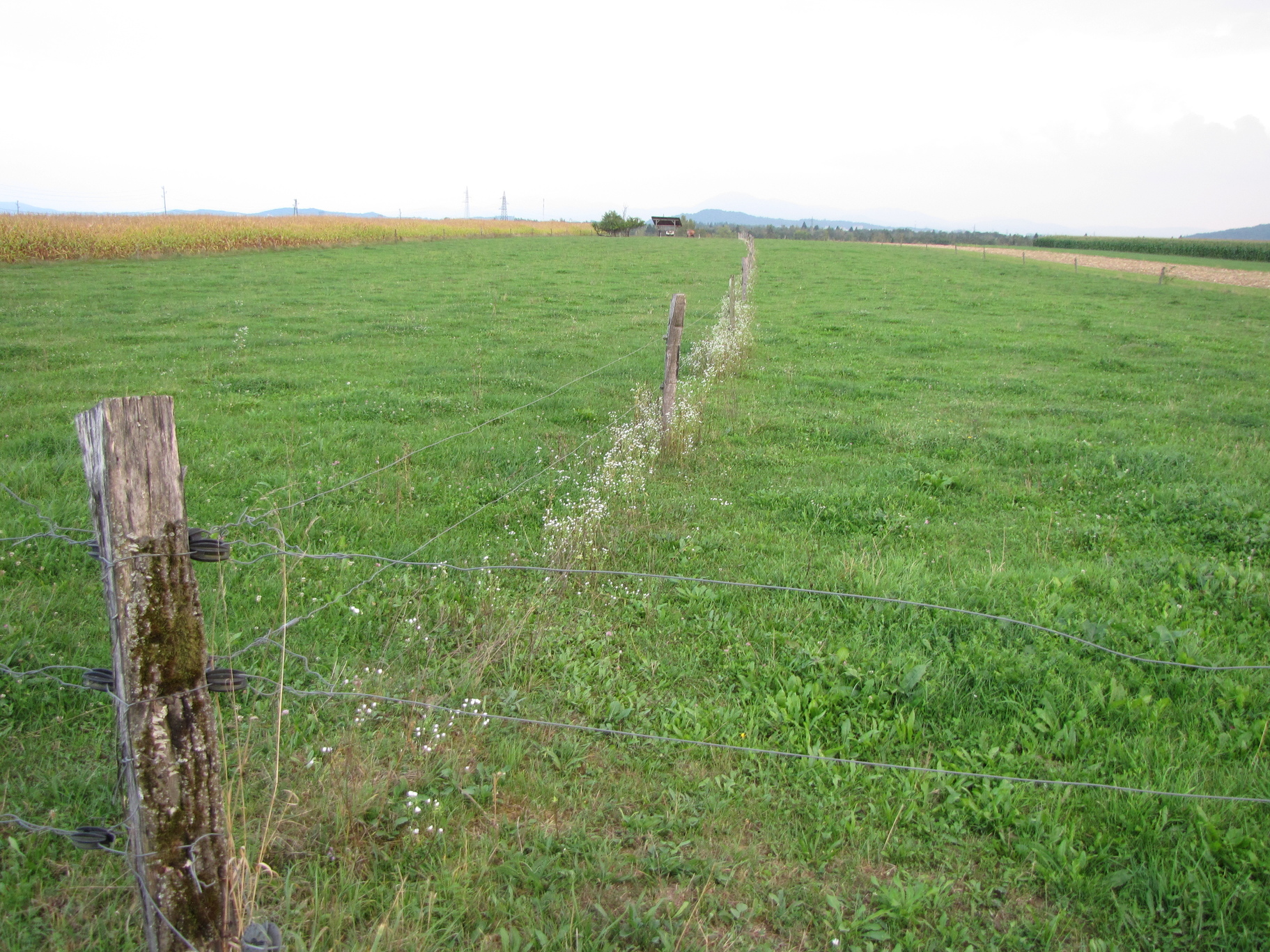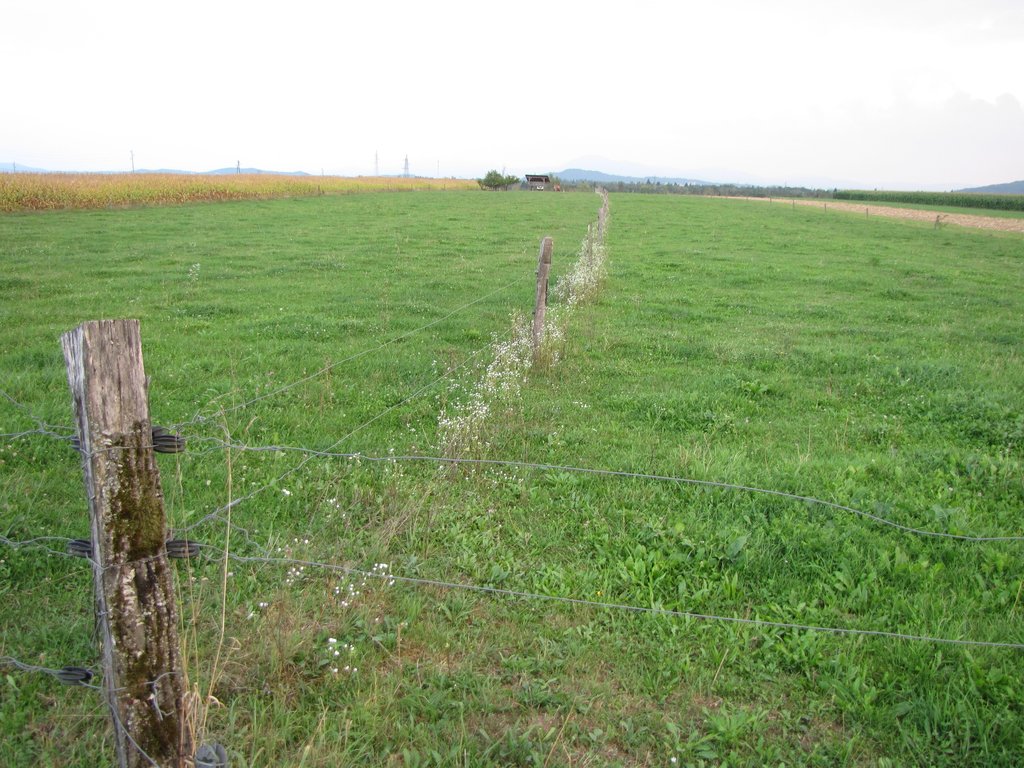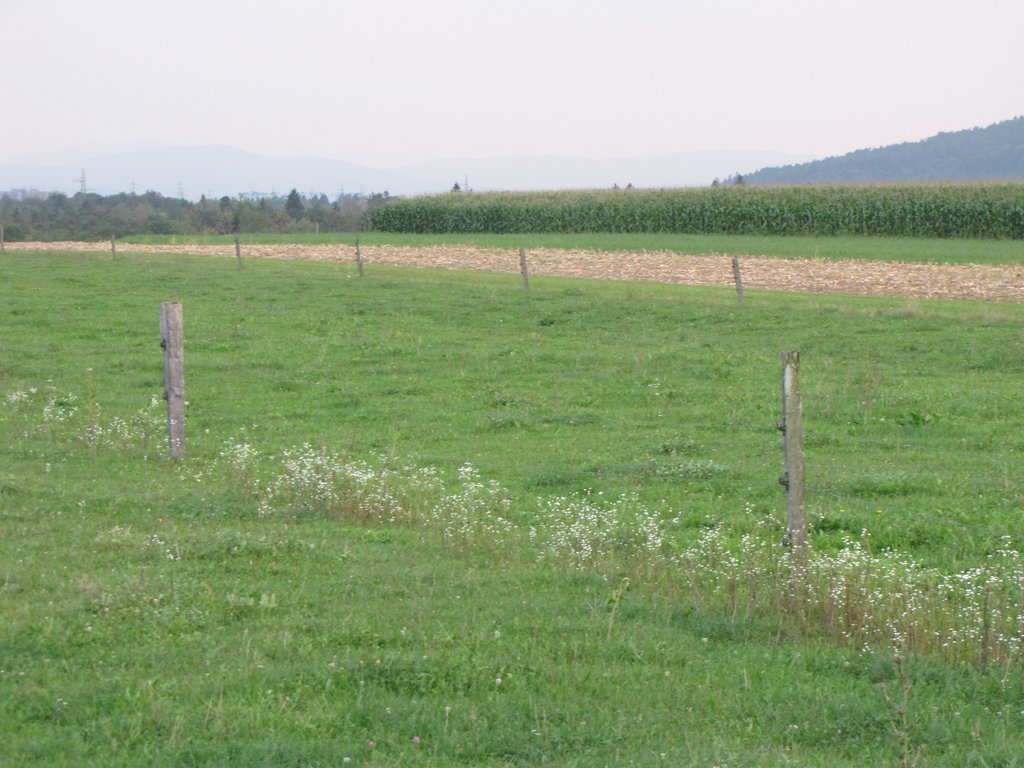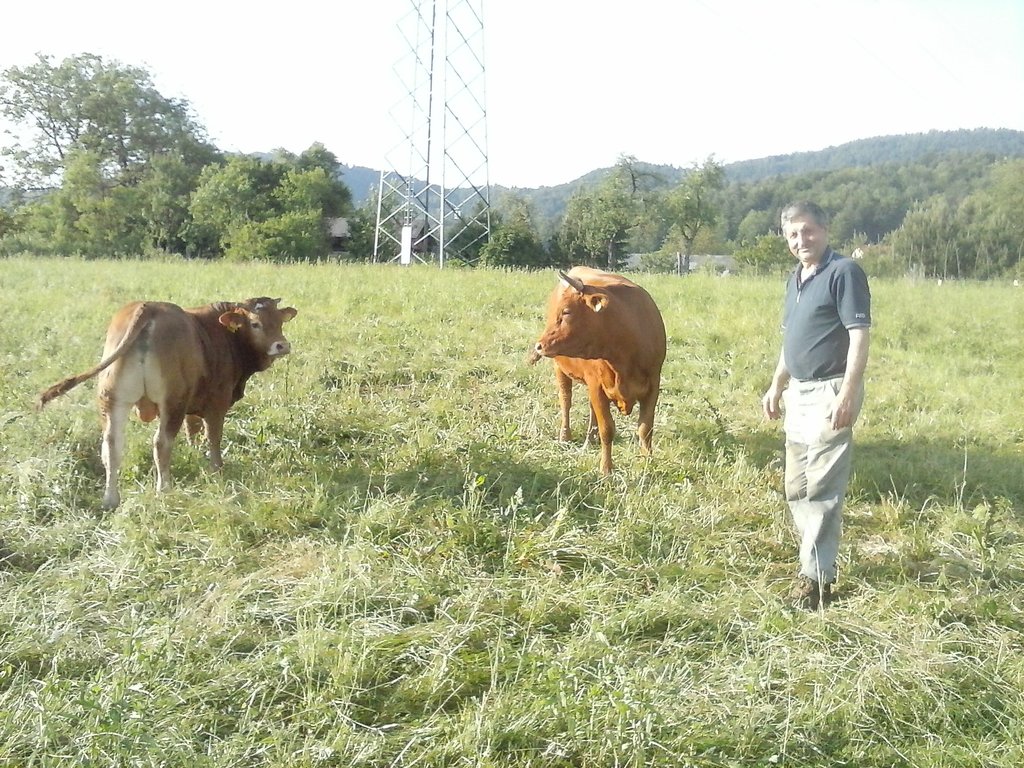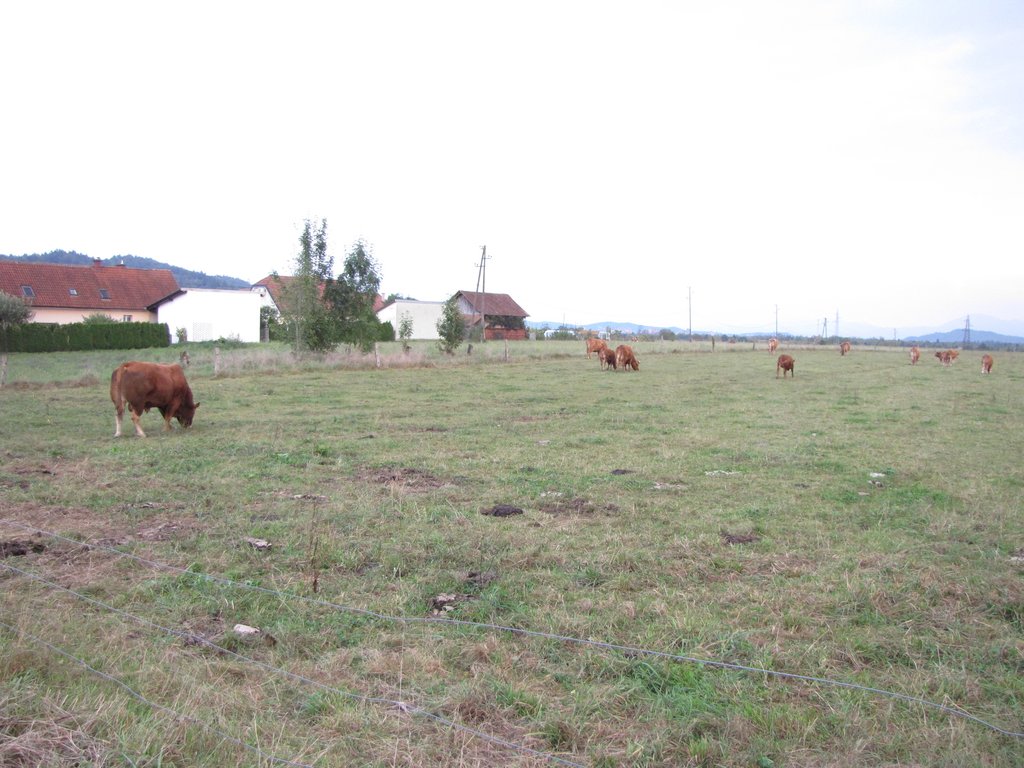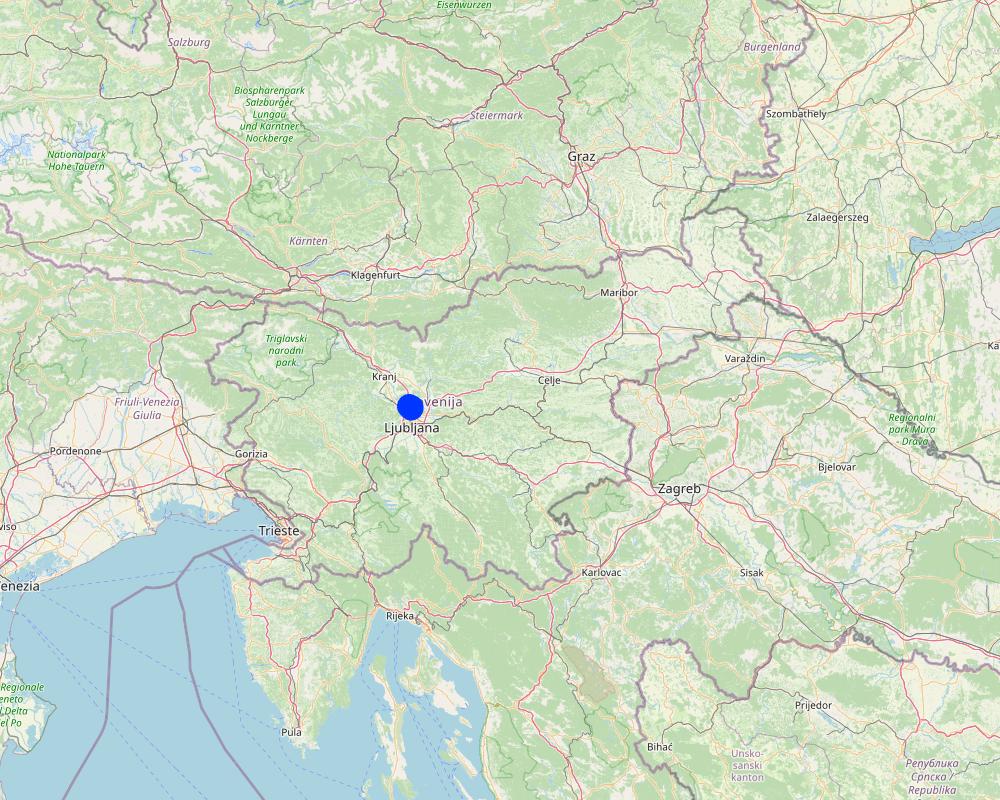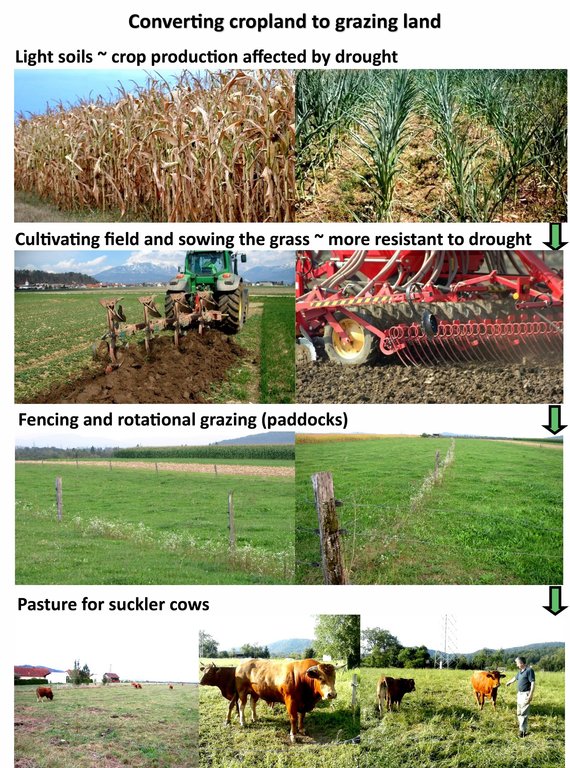Converting cropland to grazing land [Slovenia]
- Creation:
- Update:
- Compiler: Matjaz Glavan
- Editor: –
- Reviewers: Ursula Gaemperli, Gudrun Schwilch, Alexandra Gavilano, Tatenda Lemann
Pretvorba njiv v pašnike
technologies_2823 - Slovenia
View sections
Expand all Collapse all1. General information
1.2 Contact details of resource persons and institutions involved in the assessment and documentation of the Technology
Name of project which facilitated the documentation/ evaluation of the Technology (if relevant)
Interactive Soil Quality assessment in Europe and China for Agricultural productivity and Environmental Resilience (EU-iSQAPER)Name of project which facilitated the documentation/ evaluation of the Technology (if relevant)
OPtimal strategies to retAIN and re-use water and nutrients in small agricultural catchments across different soil-climatic regions in Europe (OPTAIN)Name of the institution(s) which facilitated the documentation/ evaluation of the Technology (if relevant)
Department for Agronomy, University of Ljubljana - Slovenia1.3 Conditions regarding the use of data documented through WOCAT
The compiler and key resource person(s) accept the conditions regarding the use of data documented through WOCAT:
Yes
1.4 Declaration on sustainability of the described Technology
Is the Technology described here problematic with regard to land degradation, so that it cannot be declared a sustainable land management technology?
No
Comments:
Prevenets exposure of soils to drought.
2. Description of the SLM Technology
2.1 Short description of the Technology
Definition of the Technology:
Technology is based on changing cropland to grazing land due to shallow soils with high share of rocks. This is the cause for lower yields or loss of yield during drought periods.
2.2 Detailed description of the Technology
Description:
1.The technology is applied in flatlands of Ljubljana with an average altitude of 350 m.a.s.l. The average annual precipitation is 1400 mm. The area is characterized with often stormy precipitation events and occasional droughts. Silty loam soils in the area are moderately deep to deep with medium soil organic matter. Area has good availability of surface water and groundwater of good drinking quality. Area has medium biodiversity without salinity and flooding problems. Sedentary agriculture with mixed or commercial agriculture is practiced with less than 10% of income from off-farm. Individual farm households are average in wealth and they are basically mechanized/motorized. The examined farm household, as all housholds in the region has good access to all services and infrastructures. Farm is medium in scale with land owned partly by the farmer and partly leased from other private owners.
2. Cropland area was converted to permanent grassland or pasture land by sowing of grass and by a fence as protection. Grazing is organized in a rotation system between suckler cow's pasture and paddocks.
3. The purpose of the technology is to use the natural potential of the soils. As soils are shallow with low water holding capacity permanent grassland is much more resilient and adapted to the drought; permanent grassland needs not only less water, but as well less nutrients. Grass has the capacity to grow well after any rainfall event at any time of the growing period. During drought when, maize fields get dry, grasslands subsist and just wait until the rain falls. While maize yield is lost in drought years, grassland can sustain and nurrish animals until mid-autumn. Another advantage of grassland is its building up of organic matter in the soils.
4. Main activities to establish the grazing fields are fences and electricity instalments together with grass sowing. Main maintenance activities are regular checking of the fence and electricity power and regular cleaning cuts to remove the weed at least once a year.
5. Benefits are:
(1) soils are less exposed to adverse weather conditions like drought
(2) increase of soil organic matter
(3) better resilience of the land user against production loss
(4) rise of soil biodiversity
(5) better animal welfare
(6) land user benefit from growing customer interest for meat products.
6. Land users like this better use of land resources, as less productive soils have gained new meaning. But they, on the other hand, also blame the loss of cropland needed for their maize production.
2.3 Photos of the Technology
2.5 Country/ region/ locations where the Technology has been applied and which are covered by this assessment
Country:
Slovenia
Further specification of location:
Municipality of Ljubljana
Specify the spread of the Technology:
- evenly spread over an area
If precise area is not known, indicate approximate area covered:
- < 0.1 km2 (10 ha)
Map
×2.6 Date of implementation
Indicate year of implementation:
2000
If precise year is not known, indicate approximate date:
- 10-50 years ago
2.7 Introduction of the Technology
Specify how the Technology was introduced:
- through land users' innovation
3. Classification of the SLM Technology
3.1 Main purpose(s) of the Technology
- improve production
- reduce, prevent, restore land degradation
- preserve/ improve biodiversity
- adapt to climate change/ extremes and its impacts
- create beneficial economic impact
3.2 Current land use type(s) where the Technology is applied

Grazing land
Intensive grazing/ fodder production:
- Improved pastures
Animal type:
- cattle - non-dairy beef
Products and services:
- meat
Comments:
Main animal species and products: suckler cows for fresh meat production
Number of growing seasons per year: 1
3.3 Has land use changed due to the implementation of the Technology?
Has land use changed due to the implementation of the Technology?
- Yes (Please fill out the questions below with regard to the land use before implementation of the Technology)

Cropland
- Annual cropping
Annual cropping - Specify crops:
- cereals - maize
- cereals - other
- fodder crops - alfalfa
Comments:
Previous land use was cropland (silage maize/cereals/alfalfa).
3.4 Water supply
Water supply for the land on which the Technology is applied:
- rainfed
3.5 SLM group to which the Technology belongs
- pastoralism and grazing land management
3.6 SLM measures comprising the Technology

management measures
- M1: Change of land use type
3.7 Main types of land degradation addressed by the Technology

chemical soil deterioration
- Cn: fertility decline and reduced organic matter content (not caused by erosion)

physical soil deterioration
- Pc: compaction

biological degradation
- Bh: loss of habitats
- Bq: quantity/ biomass decline
- Bp: increase of pests/ diseases, loss of predators
3.8 Prevention, reduction, or restoration of land degradation
Specify the goal of the Technology with regard to land degradation:
- prevent land degradation
- reduce land degradation
4. Technical specifications, implementation activities, inputs, and costs
4.1 Technical drawing of the Technology
Technical specifications (related to technical drawing):
Technical infographic presents reason for land use conversion (loss of yield due to drought on shallow, sandy soils) and process of conversion from ploughing, sowing, fencing and pasture establishment.
Author:
Matjaž Glavan
Date:
02/08/2017
4.2 General information regarding the calculation of inputs and costs
Specify how costs and inputs were calculated:
- per Technology area
Indicate size and area unit:
12 hectares
other/ national currency (specify):
EUR (€)
If relevant, indicate exchange rate from USD to local currency (e.g. 1 USD = 79.9 Brazilian Real): 1 USD =:
0.89
Indicate average wage cost of hired labour per day:
50
4.3 Establishment activities
| Activity | Timing (season) | |
|---|---|---|
| 1. | Land preparation | vegetational period |
| 2. | Grass sowing | All year arround, before fencing. |
| 3. | Fence installation | winter, spring |
4.4 Costs and inputs needed for establishment
| Specify input | Unit | Quantity | Costs per Unit | Total costs per input | % of costs borne by land users | |
|---|---|---|---|---|---|---|
| Labour | Fence installation | EUR/hour | 20.0 | 6.25 | 125.0 | 100.0 |
| Labour | Land preparation | EUR/hour | 2.0 | 6.25 | 12.5 | 100.0 |
| Equipment | Fence (pillars, wires and electric fence energiser) | EUR/ha | 3.0 | 266.0 | 798.0 | 100.0 |
| Plant material | grass seeds | EUR/ha | 3.0 | 200.0 | 600.0 | 100.0 |
| Total costs for establishment of the Technology | 1535.5 | |||||
| Total costs for establishment of the Technology in USD | 1725.28 | |||||
If you are unable to break down the costs in the table above, give an estimation of the total costs of establishing the Technology:
7.0
Comments:
The fence system has to be renovated every 10 years.
4.5 Maintenance/ recurrent activities
| Activity | Timing/ frequency | |
|---|---|---|
| 1. | Fence maintenance | all year around |
4.6 Costs and inputs needed for maintenance/ recurrent activities (per year)
| Specify input | Unit | Quantity | Costs per Unit | Total costs per input | % of costs borne by land users | |
|---|---|---|---|---|---|---|
| Labour | Checking the fence | EUR/hour | 8.0 | 6.25 | 50.0 | 100.0 |
| Equipment | electrical isolators for wooden pillars | pcs | 100.0 | 0.2 | 20.0 | 100.0 |
| Total costs for maintenance of the Technology | 70.0 | |||||
| Total costs for maintenance of the Technology in USD | 78.65 | |||||
Comments:
The fence system has to be renovated every 10 years.
4.7 Most important factors affecting the costs
Describe the most determinate factors affecting the costs:
Costs for fence establishment and electric fence energiser.
5. Natural and human environment
5.1 Climate
Annual rainfall
- < 250 mm
- 251-500 mm
- 501-750 mm
- 751-1,000 mm
- 1,001-1,500 mm
- 1,501-2,000 mm
- 2,001-3,000 mm
- 3,001-4,000 mm
- > 4,000 mm
Specify average annual rainfall (if known), in mm:
1352.00
Specifications/ comments on rainfall:
Average annual precipitation period is 1991-2000.
Majority of the rain falls in the autumn, followed by summer, spring and winter.
Indicate the name of the reference meteorological station considered:
Ljubljana-Bežigrad
Agro-climatic zone
- sub-humid
strong summer tunder storms and showers with local precipitation.
5.2 Topography
Slopes on average:
- flat (0-2%)
- gentle (3-5%)
- moderate (6-10%)
- rolling (11-15%)
- hilly (16-30%)
- steep (31-60%)
- very steep (>60%)
Landforms:
- plateau/plains
- ridges
- mountain slopes
- hill slopes
- footslopes
- valley floors
Altitudinal zone:
- 0-100 m a.s.l.
- 101-500 m a.s.l.
- 501-1,000 m a.s.l.
- 1,001-1,500 m a.s.l.
- 1,501-2,000 m a.s.l.
- 2,001-2,500 m a.s.l.
- 2,501-3,000 m a.s.l.
- 3,001-4,000 m a.s.l.
- > 4,000 m a.s.l.
Indicate if the Technology is specifically applied in:
- not relevant
5.3 Soils
Soil depth on average:
- very shallow (0-20 cm)
- shallow (21-50 cm)
- moderately deep (51-80 cm)
- deep (81-120 cm)
- very deep (> 120 cm)
Soil texture (topsoil):
- coarse/ light (sandy)
- medium (loamy, silty)
Soil texture (> 20 cm below surface):
- coarse/ light (sandy)
- medium (loamy, silty)
Topsoil organic matter:
- medium (1-3%)
5.4 Water availability and quality
Ground water table:
5-50 m
Availability of surface water:
medium
Water quality (untreated):
good drinking water
Is water salinity a problem?
No
Is flooding of the area occurring?
No
5.5 Biodiversity
Species diversity:
- medium
Habitat diversity:
- medium
5.6 Characteristics of land users applying the Technology
Sedentary or nomadic:
- Sedentary
Market orientation of production system:
- mixed (subsistence/ commercial)
Off-farm income:
- 10-50% of all income
Relative level of wealth:
- average
Individuals or groups:
- individual/ household
Level of mechanization:
- mechanized/ motorized
Gender:
- men
Age of land users:
- middle-aged
5.7 Average area of land used by land users applying the Technology
- < 0.5 ha
- 0.5-1 ha
- 1-2 ha
- 2-5 ha
- 5-15 ha
- 15-50 ha
- 50-100 ha
- 100-500 ha
- 500-1,000 ha
- 1,000-10,000 ha
- > 10,000 ha
Is this considered small-, medium- or large-scale (referring to local context)?
- medium-scale
5.8 Land ownership, land use rights, and water use rights
Land ownership:
- individual, not titled
- individual, titled
Land use rights:
- leased
- individual
Water use rights:
- individual
5.9 Access to services and infrastructure
health:
- poor
- moderate
- good
education:
- poor
- moderate
- good
technical assistance:
- poor
- moderate
- good
employment (e.g. off-farm):
- poor
- moderate
- good
markets:
- poor
- moderate
- good
energy:
- poor
- moderate
- good
roads and transport:
- poor
- moderate
- good
drinking water and sanitation:
- poor
- moderate
- good
financial services:
- poor
- moderate
- good
- poor
- moderate
- good
6. Impacts and concluding statements
6.1 On-site impacts the Technology has shown
Socio-economic impacts
Production
fodder production
fodder quality
land management
Income and costs
expenses on agricultural inputs
farm income
diversity of income sources
workload
Comments/ specify:
Animals have their own requirements. They need drinking water, they need to be relocated, daily observed and watch over in case of broken fence. Thus, the simplified management is not leading to a decrease of workload
Ecological impacts
Soil
soil moisture
soil compaction
Comments/ specify:
On light soils there is no differences. On clay soils it is rather worse.
Biodiversity: vegetation, animals
plant diversity
beneficial species
Climate and disaster risk reduction
drought impacts
6.2 Off-site impacts the Technology has shown
groundwater/ river pollution
6.3 Exposure and sensitivity of the Technology to gradual climate change and climate-related extremes/ disasters (as perceived by land users)
Gradual climate change
Gradual climate change
| Season | increase or decrease | How does the Technology cope with it? | |
|---|---|---|---|
| annual temperature | increase | moderately |
6.4 Cost-benefit analysis
How do the benefits compare with the establishment costs (from land users’ perspective)?
Short-term returns:
positive
Long-term returns:
positive
How do the benefits compare with the maintenance/ recurrent costs (from land users' perspective)?
Short-term returns:
positive
Long-term returns:
positive
6.5 Adoption of the Technology
- > 50%
Of all those who have adopted the Technology, how many did so spontaneously, i.e. without receiving any material incentives/ payments?
- 91-100%
6.6 Adaptation
Has the Technology been modified recently to adapt to changing conditions?
No
6.7 Strengths/ advantages/ opportunities of the Technology
| Strengths/ advantages/ opportunities in the land user’s view |
|---|
| Strengths: less grass cutting in summer time as animals are grazing. Lower costs of production. |
| Advantages: animal welfare. |
| Opportunities: diversified landscape view is an additional value. |
| Strengths/ advantages/ opportunities in the compiler’s or other key resource person’s view |
|---|
| Strengths: better use of soil /land resource. Crop like maize would bring low yields and high costs. |
| Advantages: animal welfare / better conditions and increase in biodiversity. |
| Opportunities: adaptation to rising drought events. |
6.8 Weaknesses/ disadvantages/ risks of the Technology and ways of overcoming them
| Weaknesses/ disadvantages/ risks in the land user’s view | How can they be overcome? |
|---|---|
| Weaknesses: transport of animals to the pasture in spring time. | They use lorry for transport. |
| Disadvantages: different parasites influencing animal health. | Regular use of medicine in risk areas. |
| Risks: soil compaction on heavy clay soils. | Lower density of animals. |
| Weaknesses/ disadvantages/ risks in the compiler’s or other key resource person’s view | How can they be overcome? |
|---|---|
| Weaknesses: soil compaction; overgrazing with soil exposure to external weather conditions. | Livestock density is crucial to maintain good land management. |
7. References and links
7.1 Methods/ sources of information
- field visits, field surveys
1
- interviews with land users
1 informant
When were the data compiled (in the field)?
08/06/2017
Links and modules
Expand all Collapse allLinks
No links
Modules
No modules


